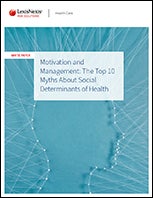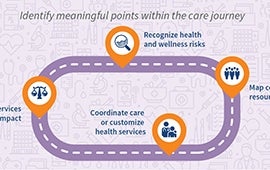Myths About Social Determinants of Health
Find the truth and separate the myths about social determinants of health (SDOH) data. When integrated into existing analytical models, it becomes vital for care management and discharge planning.
Value-based care is significantly influencing how healthcare organizations deliver care. Many health systems are struggling with care management, impeded by challenges related to hospital readmissions, medication non-compliance, low motivation levels, and more. Healthcare organizations increasingly use social determinants of health data (i.e., information on an individual’s education, economic situation, relatives and associates, assets, trends over time, and neighborhood and household characteristics) to predict and address care management challenges. These challenges can be addressed by identifying the social, economic, and environmental factors that influence health. This data is critical given the fact that at least 25 cents of every healthcare dollar is spent on the treatment of diseases or disabilities that result from potentially-changeable behavior if barriers to care were addressed. Over the last couple of years, healthcare organizations have leveraged Social Determinants of Health data for predictive modeling, enabling these organizations to improve outcomes by zeroing in on who most needs help.
Over the last couple of years, providers have used social determinants of health data to help tailor care from predictive modeling to improve outcomes. Now, the industry is moving into an ‘SDOH 2.0 phase’ in which forward-thinking organizations are looking for ways to incorporate this social and economic data at the point of care to empower providers to care for the whole patient. There is great benefit to using clinically-validated data to personalize care interventions.
Creating a complete picture of a patient
Electronic health records, survey data, and marketing data does not always paint a complete picture of the patient. This data can be outdated or not show the depth of the care, economic factors and conditions for each patient. This myopic view causes providers to miss entire patient populations that may actually be at higher risk for readmission or non-compliance with care recommendations.
Creating a complete picture of a patient includes information about housing, food insecurity, transportation needs and other socioeconomic factors. When integrated with customizable data alerts into EHR systems or layered with specific analytics like a readmission risk or medication non-adherence risk score, providers make decisions and recommend care plans that are better suited for each patient’s needs.
Download our white paper about the top ten myths about social determinants of health and learn why this data is critical to better understand and manage health risk.




